Wheelchair Seating Products - Accessories
There is more to the average seating system than a cushion and a backrest. Many accessories are available to enhance these products and create a system that caters to the needs of the wheelchair user. Below I've listed a number of the more common products and a short description of each. I've started at the feet and will work my way up the body.
Feet and Lower Legs
The user's feet and lower legs must be controlled in order to maintain a proper seating position. Ideally the user themselves is able to control their feet and lower legs but if not there are a couple of options.
Heel loops are mounted on the back of the foot plate to prevent the user's feet from slipping off backwards. They are straps about 2' wide which are mounted across the back of the foot plate. Often, the heel loops get trampled on by the user and flattened making them unusable but they will work for some people.
Toe loops are straps about 1" wide which are attached to the front of the foot plate and loop across the top of the user's feet preventing the feet from slipping forward. When used in conjunction with heel loops the feet are virtually locked to the foot plates.

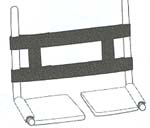
Leg panels are just double leg straps with a lightly padded cover over them which can be used in front or behind the lower legs.
Foot boxes can be custom made for those who can't tolerate straps. A footbox is a three sided padded box which contain the feet.
Knees and Upper Legs
Some wheelchair user's knees will splay out, press inward or windsweep to one side or the other. There are a few products available to help control these conditions.
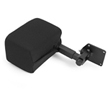
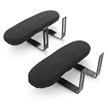
Hips and Buttocks
Drop bases are solid platforms mounted to a wheelchair that can lower, raise or tilt

Seat belts, also known as positioning belts, are attached to the wheelchair near the back of the cushion or base and are used to prevent the user's buttocks from

Four point seat belts can be utilised when a regular seat belt is not enough to control the seating position. Four point seat belts have one strap on each side which are attached to the wheelchair frame mid way between the front and the rear of the seat on each side one strap which attach to the back post of the wheelchair. This seat belt will exert pressure to hold the user down and back in the seat.
For more information about hip positioning and seat options please visit our new page at: https://mobilitybasics.ca/seating/hip-supports
Arms
Extra wide arm pads are available for users who have trouble keeping thier elbows and lower arms resting on standard 2" arm pads. They measure about 4" wide and the same length as standard arm pads.
Elbow blocks ar available to help keep the user's arm on the wide arm pads or a wheelchair tray. They can be various shapes and sizes but all will prevent the elbow from sliding off the arm to the outside of the arm pad or tray as well as sliding back off the arm pad or tray.
When something more than a conventional arm pad is needed to support the arm, arm troughs are manufactured by a few companies. these troughs can usually be mounted on an angle if needed and straps can be utilised to further secure the arm.
Torso
Lateral supports prevent the torso from leaning to the left or right and they can be
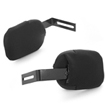
Chest straps are straps which are about 2" wide which wrap around the torso just below the arm pits to hold the user upright and stable. The chest strap may or may not be padded.
Shoulder straps are similar to backpack straps. They are padded straps which are

Head
Headrests can vary quite a bit in complexity and cost and choosing the right one
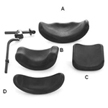
A basic headrest is simply a pad attached to an adjustable and removable mounting system. The basic hearest is suitable for user's who have good head control and just want something to rest their head against when tired.
A curved headrest curves around the sides of the head to provide some lateral support for users who have a little difficulty controling their head. There are various shapes and sizes of curved headrests and a little trial and error may be required to determine the correct one.
Modular headrests are quite complicated and expensive systems. Setting up a modular headrest system requires some time as there are many pads that can be used mounted in many different positions. With modular headrest systems, many adjustments can be made as needed.
Forehead pads are options on the modular headrest systems to prevent the user's head from falling forward off the headrest.
Head straps are straps attached to the headrest which wrap around the forehead of the user and hold the head secure. Generally, nobody likes to use a headstrap but in some cases they are the only option for head control and work well in the right situations. Head straps can be used with the modular headrest system or the more basic headrests.


 Online Vendors
Online Vendors  US Online Vendors
US Online Vendors 